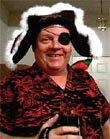|
|
This topic comprises 4 pages: 1 2 3 4
|
|
Author
|
Topic: Flying Lessons (questions)
|
Jason Black
Phenomenal Film Handler

Posts: 1723
From: Myrtle Beach, SC, USA
Registered: Nov 2000
|
 posted 09-17-2007 10:55 PM
posted 09-17-2007 10:55 PM





A call to any pilots we have onboard..
I'm consindering taking flying lessons sometime next year. ar ethere any special things I should look for in looking for a school? There are a few places locally (MYR) that offer lessons.. Just not sure what the certifications I shoudl look for would be.
Also, what are the typical requirements, ground time, air time, etc, for one to obtain a recreational (non commercial) license? There are a few of us at work who are interested in lessons. Knowing them as well as I do, if a few of us actually got into this and enjoyed it, they'd look at Pipers or Cessna's to buy as a group. It would be a tax write off for them anyway... ![[Smile]](smile.gif)
Just curious as to what I should begin to look for, and any questions I should ask. I've also always "heard" that lessons are EXPENSIVE... Any truth to this?
Thanks for any input..
| IP: Logged
|
|
|
|
Monte L Fullmer
Film God

Posts: 8367
From: Nampa, Idaho, USA
Registered: Nov 2004
|
 posted 09-18-2007 12:06 AM
posted 09-18-2007 12:06 AM




..and learn in a LINK's trainer, not by computer method. Learn how to do flight plans the old fashioned way by filling the forms out, not by computer method.
Also, when getting behind the stick, learn on the "tail draggers" first in as well as using instruments.
Yea, plan on hitting the books, for you have to really know weather-inside and out, yearly physicals, different classes of licenses - from experimental to passenger...and the expenditures required for flying.
My father has his own plane (an 1946 Ercoupe) and has had it for years besides building planes for others. He's 81 and can still pass physicals but just maintains an experimental licence due his occasional cloudhopping. He wanted to fly in the war, but couldn't since they didn't need pilots just infantrymen. When he got out, he immediately got his license to fly..where later on, he got on with the FAA to be in Flight Station (a degree below the tower operators-mainly handling light and twin engine aircraft.not the commercial aircraft department) and retired from the FAA as well.
We both shake our heads when we see aircraft accidents and near misses due to these new 'crackerjack' pilots who's received their licence in such items and think they know everything.
BUT, when you leave mother earth, you're at the mercy of the weather and her elements. For she's not too friendly with man powered flight at times.
Learn as much of her as you can and do your best at it. She's a bit tempermental at times, but if you know all of the ropes, you can control yourself around her ire.
If you would like more help, please PM, or email me and I can ask my father on any hints he can send your way ..
good luck-Monte
| IP: Logged
|
|
|
|
Paul Mayer
Oh get out of it Melvin, before it pulls you under!

Posts: 3836
From: Albuquerque, NM
Registered: Feb 2000
|
 posted 09-18-2007 01:44 AM
posted 09-18-2007 01:44 AM





Tricycles are for children Phil... ![[evil]](graemlins/evil.gif)
Real pilots (as opposed to reel pilots) fly conventional gear - none of that newfangled sissy tricycle junk. Me? Soloed in 1974 in a Bellanca 7ECA Citabria then stopped due to lack of $$$. Soloed again in 1977 in a 1947 Cessna 140. Finally got my PPL in 1978.
I remember Jason asking about this a couple of years ago. Private pilots? You're finally ready to give it a try Jason? Great!
As for me, I just can't get over what it costs just to stay day VFR current in a single these days, based on what my students at the college have told me.
There are basically two kinds of flight schools - those that operate under FAR Part 141, and those that don't. The Part 141 schools are more rigid in their curriculums and tend to cost more. But the flight experience requirements (the number of hours needed before taking the exam ride) are lower and the training quality is seen by some as being more uniform.
I didn't use a Part 141 school when I trained. In the end I feel that it's the quality of the individual instructor(s), and the learning ability of the student, that will have a far greater impact in leading to a successful flight training experience.
As to what to look for, hang out at the airport and talk to as many local pilots, students, and instructors as you can. You'll quickly learn what the local reputations are. Look at the planes too. Do they look good or do they look like they've been ridden hard and put away sweaty? Ratty airplanes are a sign the school is struggling too much financially. All flight schools struggle financially, but there is a line.
Same with the instructors. Is your potential CFI really interested in teaching or is s/he just building time towards a flying job? The time builder will drop you and his/her other students like hot rocks as soon as a flying job comes up. Generally it's the older guys that make the better instructors - they've been around a while.
| IP: Logged
|
|
|
|
|
|
|
|
|
|
Paul Mayer
Oh get out of it Melvin, before it pulls you under!

Posts: 3836
From: Albuquerque, NM
Registered: Feb 2000
|
 posted 09-18-2007 02:03 PM
posted 09-18-2007 02:03 PM





In my experience T-tailed aircraft don't handle as well as those that have the tail where it belongs. I don't have any time in MD-80s other than in a simulator but have talked with a lot of pilots that do, and the general consensus is that the MD-80 is a bit 'squirrelly' when in the approach configuration. It's certainly not alone in that characteristic - heck, the Twin Otter can be a handful in a gusting crosswind. But any certified design has to have control response that any reasonably qualified pilot can handle, and the MD-80 most certainly does.
Windshear is a problem in any aircraft, but especially with large aircraft due the weight and momentum involved. Big airplanes just can't react a quickly as smaller ones can, and so things like early windshear detection and proper response to it become critical. It'll be interesting to see what happened with One Two Go at Phuket.
Despite some airlines crying "pilot shortage" there is no such thing, at least at the larger air carriers. My company for example requires a minimum of 3000 hours flight time from its pilot applicants and we get many more applications than we can handle even though we're an LCC with LCC wages. The average guy or gal we hire has anywhere from 4500 to 6000 hours, many of them PIC qualified on regional jets.
But at the regional level, things are beginning to get a little tight. Anyone with enough time is bailing out of the regionals to go to the bigger carriers, and it's beginning to look like there's not enough replacement people willing to put up with the lousy pay and working conditions that are the norm at the regional level. The one's that do are desperate, or have working spouses or parents to support them during this 'pay your dues' career phase. They will put up with it, but they generally are low-time CFIs or recent graduates of some airline academy, typically with no more than 200 to 500 hours total time.
Such people are fine as co-pilots but they will require several years of seasoning flying with experienced captains before they can move to the left seat. The problem occurs when the captains bail out before their replacements are up to speed. If a carrier can't find enough qualified captains to hire off the street, that's when you see some pretty low time people being asked to step up. Fortunately the vast vast majority of them do just fine with the challenge.
| IP: Logged
|
|
|
|
Leo Enticknap
Film God

Posts: 7474
From: Loma Linda, CA
Registered: Jul 2000
|
 posted 09-18-2007 04:35 PM
posted 09-18-2007 04:35 PM





quote: Paul Mayer
In my experience T-tailed aircraft don't handle as well as those that have the tail where it belongs.
Interesting. The KLM MME-AMS flight, which I do as a passenger around 5-10 times a year, is sometimes operated by a Fokker 50 (tail where it belongs) and sometimes by a Fokker 70 (looks very similar to a DC-9 to my untrained eyes). If the weather over the North Sea is seriously windy, the Fokker 70 tends to start this weird side-to-side rocking motion that doesn't feel massively violent, but leaves you not wanting to eat or drink anything much for hours after the flight. On the approach to landing, especially a landing from the west at Teesside, the wings often dip and correct significantly, really quite close to the ground, giving the impression that the pilot is finding it hard work to keep the aircraft level. Sorry if this sounds like jumping to conclusions - I just get the feeling that something isn't quite right when the weather gets bad. I never get that worry at the back of my mind in the Fokker 50 - it seems to be able to fly through anything nature can throw at it, completely stable. Would I be right in guessing that the T-shaped tailed aircraft are more efficient at high speed/high altitude cruising, but these aircraft are more difficult to control during take-off/climb and approach/landing phases in bad weather?
| IP: Logged
|
|
|
|
|
|
|
|
|
|
All times are Central (GMT -6:00)
|
This topic comprises 4 pages: 1 2 3 4
|
Powered by Infopop Corporation
UBB.classicTM
6.3.1.2
The Film-Tech Forums are designed for various members related to the cinema industry to express their opinions, viewpoints and testimonials on various products, services and events based upon speculation, personal knowledge and factual information through use, therefore all views represented here allow no liability upon the publishers of this web site and the owners of said views assume no liability for any ill will resulting from these postings. The posts made here are for educational as well as entertainment purposes and as such anyone viewing this portion of the website must accept these views as statements of the author of that opinion
and agrees to release the authors from any and all liability.
|

 Home
Home
 Products
Products
 Store
Store
 Forum
Forum
 Warehouse
Warehouse
 Contact Us
Contact Us




 Printer-friendly view of this topic
Printer-friendly view of this topic






![[Smile]](smile.gif)



![[Roll Eyes]](rolleyes.gif)

![[evil]](graemlins/evil.gif)
![[fu]](graemlins/fu.gif)
![[Wink]](wink.gif)
![[Razz]](tongue.gif)
![[Embarrassed]](redface.gif) Did have a chance once to add a DC-3 type rating to my ticket, back when I was made of $$$.
Did have a chance once to add a DC-3 type rating to my ticket, back when I was made of $$$.





